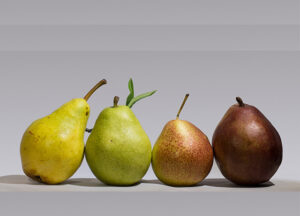PEARS

Pears are nice to eat, and the word ‘pear’ is nice to say, don’t you think? Pears fit neatly in your hand and they have a very maternal shape, triggering all sorts of primal emotions of comfort and safety. Although apples have assumed iconic status within the world of fruit, pears closely follow being the second most cultivated fruit in the sub-tropics and having an instantly recognisable graphic profile. Pears have been used as a traditional folk remedy in China for 2000 years.
There are loads of pear varieties of different colours and sizes, and their sugars content varies. A green skinned pear (150g) contains around 18g of sugars, about equal amounts of fructose and glucose. Sweeter varieties are delicious to eat raw while lower sugar varieties are good for cooking (and you add the sugar yourself). Ripeness also affects sweetness; I love a crunchy, less sweet pear, while others prefer their pears riper, softer and sweeter. Pears ripen after picking and best left on the benchtop until just right and then transferred to the fridge taking care to avoid squashing and bruising.
Pears are a good source of vitamin C and fibre, including soluble fibre that helps with blood cholesterol levels – eat the skin to retain it. They’re also rich in the B-vitamin folate and contain potassium and polyphenols (antioxidants). Pears, like apples, have a low glycemic index so they have a gentle effect on blood glucose levels and provide longer lasting energy.
While pears are great fresh, they are also delicious cooked. Stewed pears and vanilla yoghurt or ice cream is simply wonderful. Poach them in red wine for fabulous flavour and colour. Pears also star in fabulous desserts like crumbles, tarts and cakes. Cooked pear makes a delicious accompaniment to pork (apple sauce is traditional) and is amazing with cheese, especially strongly flavoured blue cheese. Try a salad with pear and parmesan, or blue cheese and walnuts. For everyday good nutrition you can switch out apple for pear when making Bircher muesli for a great start to the day.
| Pear, green skinned and unpeeled | |
| 5 Health Stars | |
| Glycemic index (depending on ripeness) | 24 – 33 |
| Serving size – 1 small pear (150 g or 5.3 oz) | |
| Kilojoules | 415 |
| Calories | 99 |
| Protein (g) | 0.6 |
| Fats (g) – total | 0 |
| Includes: – Saturated fat (g) | 0 |
| – Monounsaturated fat (g) | 0 |
| – Polyunsaturated fat (g) | 0 |
| Saturated : unsaturated fat ratio | N/a |
| Carbohydrates (g) – Total | 23.1 |
| Available (Includes): | 18.6 |
| –Natural sugars (g) | 18.6 |
| –Natural starches (g) | 0.0 |
| –Added sugars (g) | 0.0 |
| –Added starches (g) | 0.0 |
| Unavailable (Includes): | 4.5 |
| –Dietary fibre (g) | 4.5 |
| Sodium (mg) | 0 |
| Potassium (mg) | 195 |
| Vitamin C (mg) | 3 |
| Folate (ug) | 66 |
| Total polyphenols (mg)* | 267 GAE |
| Glycemic load (g) | 4.5 – 6 |
| Diabetes exchanges | 1 |
| Ingredients: Pear |








